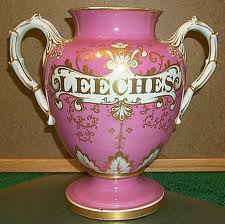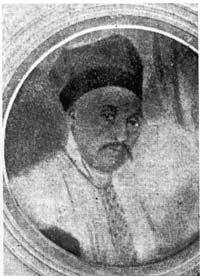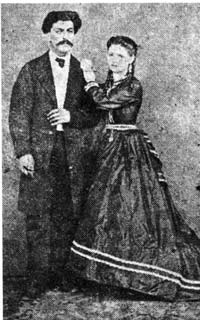|
 The Abbott Brothers of Salonica The Abbott Brothers of Salonica 
(version May 13, 2021)
Please email corrections to Mike Clark

Bartholomew Edward Abbott in the late 1700s, as a representative of the Levant Company, dominated British commerce in the Greek city of Salonica (Thessalonika), and his grandsons, primarily John Abbott and John's bothers Robert and Alfred, monopolized the import and export of several profitable commodities in that region 50 years later through their merchantile firm of Abbott Brothers. One commodity traded by the Abbott Brothers were leeches that were used by physicians of the time to "bleed patients". These leeches were "fished" from wells sunk into marshes on the outskirts of the city, and because centuries of leech collecting in western Europe had severely depeleted the supplies there, the leech trade out of Greece was most profitable. Meropi Anastassiadou (1997) in her study of Salonica during the waning days of the Ottoman Empire writes that the French Consul there observed in 1849 that
 "the trade of leeches is a monopoly; fishing rights are allocated by auction in Constantinople. A company of English origin [i.e., Abbott Brothers] has been the highest bidder for many years, controlling the monopoly, and thereby built a very great fortune; here, they resell the leeches to an Austrian merchant who then sends them to Trieste at his own risk."
"the trade of leeches is a monopoly; fishing rights are allocated by auction in Constantinople. A company of English origin [i.e., Abbott Brothers] has been the highest bidder for many years, controlling the monopoly, and thereby built a very great fortune; here, they resell the leeches to an Austrian merchant who then sends them to Trieste at his own risk."
Then the consul in 1851 adds that the "Abbott Brothers, English subjects, have a capital of approximately 1,500,000 piastres. They work little themselves for their business; their principal earnings abroad come from commissions. London, Marseilles, Amsterdam, Vienna, Genoa, Trieste, Malta, Syria, Smyrna, and Constantinople are their centres of operation. They receive from these various ports refined sugars, coffees, leathers from Buenos Aires, and salt which they sell on behalf of their representatives; in exchange, they ship cereals, oleaginous seeds, and promissory notes as reimbursement for the goods that they have sold. The trade that gives them the greatest profit is that of the leeches from the Pachalik of Salonica over which they have held the monopoly for many years. Moreover, they make considerable speculations on the spot in cereals that they buy from the pashas, the beys, and the large landowners of Macedonia. Their great influence over the Turkish authorities facilitates their business and this influence is due to the fact that they are the money lenders of the pashas, the beys of the country, etc. who turn to them to obtain cash advances on the produce from future harvests. These merchants are owners of a mill that spins silk in the manner of the Italian Piedmont region, with annual production rising to 2,000 kgs, exported in major part to London, and the remainder to Marseilles."

Mazower (2004) adds some additional information on the Abbott Brothers: "John ‘Jackie’ Abbott was ‘Greek by religion, British by nationality’. His family had been settled in the city for over fifty years but he had been the real architect of its rise. A mid-century photograph shows a plump man in a morning coat, his large necktie carelessly knotted, starring aggressively at the camera as though keen to get back to work. His fortune came originally from cultivating and trading in leeches, an indispensable commodity for local healers. But the leeches signified something else as well, for Abbott had used his wealth to turn himself into one of the region’s chief money-lenders by ‘corrupting the authorities and thereby committing all kinds of acts of injustice.’ In addition to Sadik Pasha [the local ruler], Abbott also had the city’s Greek metropolitan in his debt, and several of the leading beys – a majority, in fact, of the advisory council. He was a good example of what Urquhart called ‘the hidden mechanism which sets the administrative machine of Turkey in motion’. His lavish bribes to successive pashas and their secretaries included money, snuff boxes and diamond-studded pipes, sufficient to get his rivals thrown into jail and making a dangerous man to cross (according to one version of the tale he had started out in life by murdering a competitor, the Jewish owner of the finest local leech-farm). By the time of [Sultan] Abdul Mecid’s visit, his interests extended to more than twenty-five landed estates and numerous villages whose peasants laboured to repay the extortionate interest rates he charged."
 Lineage of the Abbott Brothers of Salonica Lineage of the Abbott Brothers of Salonica 
 Batholomew Edward Abbott (c.1739-1817) was one of the younger sons of Peter Abbott, a treasurer for the British Levant Company in Constantinople. Bartholomew was probably born in either Ankara, Turkey or Aleppo, Syria, and spent several years as a merchant in various parts of the Ottoman Empire before arriving in 1771, some say with a Greek wife, in the city of Salonica (Thessalonica) on the east coast of Macedonia. Although Salonica was one of the less profitable "factories" (i.e., trade centers) controlled by the Levant Company, Bartholomew built an extensive trade network and substantially increased British exports and imports. He was admitted as a freeman to the company in 1794, and even though he was never appointed the company consul in Salonica, he nonetheless set the foundations for several Greek trading monopolies that his family controlled for the next century. Bartholomew married his second wife Sarah Anartary (d. 1818), the widow of French Merchant Gabriel Chaussaud, about 1778, or possibly later. He raised her son Peter Chausseaud (1756-1843) as his own, even taking on Peter as his business partner. Batholomew and Sarah also had at least three children of their own, including their eldest child George Frederick Abbott (b. c.1776), who follows, and two younger daughters - Annetta (b. c.1789) and Maria Canella (b. c.1791). Batholomew died on March 18, 1817 in Salonica, and Sarah died on January 20, the following year (Vlami, 2009). His ancestry is covered in the section on the Abbott Family Genealogy.
Batholomew Edward Abbott (c.1739-1817) was one of the younger sons of Peter Abbott, a treasurer for the British Levant Company in Constantinople. Bartholomew was probably born in either Ankara, Turkey or Aleppo, Syria, and spent several years as a merchant in various parts of the Ottoman Empire before arriving in 1771, some say with a Greek wife, in the city of Salonica (Thessalonica) on the east coast of Macedonia. Although Salonica was one of the less profitable "factories" (i.e., trade centers) controlled by the Levant Company, Bartholomew built an extensive trade network and substantially increased British exports and imports. He was admitted as a freeman to the company in 1794, and even though he was never appointed the company consul in Salonica, he nonetheless set the foundations for several Greek trading monopolies that his family controlled for the next century. Bartholomew married his second wife Sarah Anartary (d. 1818), the widow of French Merchant Gabriel Chaussaud, about 1778, or possibly later. He raised her son Peter Chausseaud (1756-1843) as his own, even taking on Peter as his business partner. Batholomew and Sarah also had at least three children of their own, including their eldest child George Frederick Abbott (b. c.1776), who follows, and two younger daughters - Annetta (b. c.1789) and Maria Canella (b. c.1791). Batholomew died on March 18, 1817 in Salonica, and Sarah died on January 20, the following year (Vlami, 2009). His ancestry is covered in the section on the Abbott Family Genealogy. 
George Frederic Abbott (c.1776-1852), the first child of Batholomew Edward Abbott and Sarah Anartary, was born about 1776, or possibly earlier, in Salonica, and raised in the Greek Orthodox faith. When his father died, George and his older half-brother Peter Chausseud carried on the family business interests. However, the two eventually had a falling out, and went their separate ways. George, in time, was succeeded in the business by his sons who operated the family trade monopolies in Salonica under the firm of "Abbott Brothers".
 Although they controlled British trade in much of Greece for a number of commodities, their most profitable exports to Britain are said to have been Turkish tobacco and medical leeches. George had three wives, and supposedly many children from each marriage. However, we only know of children from the first and third marriages. Although they controlled British trade in much of Greece for a number of commodities, their most profitable exports to Britain are said to have been Turkish tobacco and medical leeches. George had three wives, and supposedly many children from each marriage. However, we only know of children from the first and third marriages. 
children (with 1st wife Domina Caftandjoglou, marriage in 1802)
Caroline Sarah Abbott (b. c.1802) married Felix Lafont (1792-1840), who had succeeded his father Gabriel Lafont as the favored doctor to French expatriots living in Salonica. Caroline is said to have been 16 or 17 at the time of her wedding on December 2, 1819, which makes 1802 or 1803 the approximate date for her birth. Although the death of her husband her husband left her with several small children, she was able take a second husband on September 15, 1845 when she married Charles Goy, a Swiss merchant. John Nelson "Jackie" Abbott, Sr. (c.1802/1806-1875?), who was called Jackie (Djeckis) by his friends, was born in the early 1800s - about 1802 in some accounts, and about 1806 in others. He was the oldest son of George Frederic Abbott, and he headed the firm of Abbott Brothers in Salonica. He is portrayed by his contemporaries as a ruthless businessman, who early in his career supposedly murdered a Jewish Merchant who owned a "leech well" that Jackie wanted to control. The French consul writes in 1835 that Jackie, "was the subject of complaints [in Salonica] and acquired the aversion of everyone; he had no other resource but to take his industry to Volos [a Greek port south of Salonica]. He left his brother Robert Abbott in Salonica, hardly better off than himself, but who was able to put up with the general contempt. They are English in name only because they were born here" (Anastassiadou, 1997).
Jackie and his family lived in an elaborate mansion on Frank (Fragkon) Street in Salonica that he built about 1840 at great cost (Karatzoglou, 2004). However, competition from other trading firms caused his fortunes to decline, and he was forced to sell the building to the Imperial Ottoman Bank, which as early as 1864 may have been operating out of the Abbott mansion. The bank was subsequently destroyed in 1903 in a gas explosion and resulting fire caused by Bulgarian terrorists. It was replaced soon thereafter by a building that today houses the State Conservatory of Thessalonika. An 1875 case file in the British Archives that concerns the Turkish estate of John Nelson Abbott is probably his and gives us a likely death date (Reference FO 780/48). 
John Nelson Abbott, Jr. (c.1829-1893) wrote a book in 1849 titled "Sketches of Modern Athens" that recounts his time as a student at the Royal Greek Gymnasium in Athens. He was then admitted on Dec. 11, 1849 to Trinity College at Cambridge University, England, where he matriculated on Michelmas Day (Sept. 29) 1850, and earned a B.A. degree there in 1854. He married Jessie Leisk Sutherland in 1860 at St George Hanover Square, in London, and they had several children, all born in England.
Robert "Babbi" Abbott (d. 1874) formed a partnership on Sept. 1, 1833 in Salonica, Greece (then part of Turkey) with his brother John in the Abbott Brothers firm, but after a bitter quarrel, the two formaly severed their business ties 34 years later. They subsequently became embroiled in a complex trial in the British court in Constantinople over the division of their business assets. Robert is believed to have been younger than John. He married a Greek woman named Catherine Heraklides (d. 1903), about whom nothing more is known except her death and burial. He died on May 24, 1874 in Greece, and is buried there with his wife in the Evangelista Greek Orthodox Cemetery in Salonica (Thessaloniki). 
Edmund Abbott (1832-1884), one of the sons of Robert Abbott and Catherine Heraklides, he is known only from his tombstone in the Evangelista Greek Orthodox Cemetery in Salonica (Thessaloniki), Greece. Alfred Abbott (1836-1921) was living in Salonica (Thessaloniki), Greece at the time when his brother Henry was murdered there by a Turkish mob. He is buried in the Evangelista Greek Orthodox Cemetery in Salonica. Henry Abbott (1841-1876) owned extensive forests on the slopes of Mt. Olympus, the logs from which were fashioned locally into ship girders and exported by Henry to British shipyards at considerable profit. Though a British citizen, he became the German Consul in Salonica, Greece, and was serving in that capacity when he was killed on May 6, 1876 by a Turkish in the city, for attempting to intercede in the kidnapping of a Christian girl. His brother-in-law Jules Moulin, the French Consul, was killed in the same incident, which resulted in Turkish, Greek, British, French, Russian, and Italian warships being dispatched to the Thessaloniki harbor. Alfred Abbott, the brother of Henry, provided most of the information for an account on the murder that appeared in the June 17, 1876 issue of the Illustrated London News. He is buried in the Evangelista Greek Orthodox Cemetery in Salonica. There is additional information on the Salonica incident in a Wikipedia article. Mary Abbott (b. 1850) married Pierre Jules Moulin (1836-1876), the French Cousul in Salonica, who was killed there by a Turkish mob at the same time as Mary's brother Henry. Nothing more is known of Mary, but there is a memorial to her husband in the Montparnasse Cemetery in Paris, France.
children (with 2nd wife Georgetta "Coconella" Giustiniani, marriage in 1817)
children names unknown, but some are said to have existed.
children (with 3rd wife Aneza Fundria, marriage in 1823)
Batholomew Edward Abbott (1830-1914) Peter Abbott (c.1835-1882) was probably born in Salonica and most likely died there as well. His grandson Jasper Abbott shows Peter's wife as Anna Constuce Kalipolitan. Although Peter and Anna had several children, they are best known as the parents of George Frederick Abbott (1874-1947), who gained fame as a British War Correspondant during the First World War, and who wrote several books on Ottoman Empire. Several other children were also born from this third marriage.

REFERENCES:
Anastassiadou, Meropi (1997), Salonique, 1830-1912: une ville ottomane à l'âge des Réformes (The Ottoman Empire and Its Heritage : Politics, Society and Economy, New York. Mazower, Mark (2004), Salonica, City of Ghosts: Christians, Muslims and Jews 1430-1950, Harper 2004, p. 155 Giraud, Nadia (2006), Searching for Distant Relations, the Abbotts of Salonica on the Levantine Heritage website. Last accessed 13 May 2021. Giraud, Nadia (2017), Abbott: The Start of the Saga on the Rizes Genealogy Website. Last accessed 13 May 2021. Giraud, Nadia (2017), Abbott House on the Rizes Genealogy Website. Last accessed 13 May 2021. Giunti, Matteo, Abbott Family Genealogy on the Leghorn Merchant Networks Project website. Karatzoglou, John (2004), The Imperial Ottoman Bank in Salonica: First 25 Years 1864-1890, published by Osmanli Bankasi Arsiv ve Arastirma Merkezi, 52 p. Stallard, Gen. Stacy Frampton and Stallard, Hamilton George Frampton, undated, Abbott Pedigree, a large pedigree chart compiled by the Stallard brothers before their deaths in 1961 and 1952. Vlami, Despina (2009), Entrepreneurship and Relational Capital in a Levantine Context: The Abbotts of Salonica (18th-19th Century). This article is also available at Scribd.com. Last accessed 17 Apr 2020.
|
 The Abbott Brothers of Salonica
The Abbott Brothers of Salonica 

 "the trade of leeches is a monopoly; fishing rights are allocated by auction in Constantinople. A company of English origin [i.e., Abbott Brothers] has been the highest bidder for many years, controlling the monopoly, and thereby built a very great fortune; here, they resell the leeches to an Austrian merchant who then sends them to Trieste at his own risk."
"the trade of leeches is a monopoly; fishing rights are allocated by auction in Constantinople. A company of English origin [i.e., Abbott Brothers] has been the highest bidder for many years, controlling the monopoly, and thereby built a very great fortune; here, they resell the leeches to an Austrian merchant who then sends them to Trieste at his own risk." Batholomew Edward Abbott (c.1739-1817) was one of the younger sons of
Batholomew Edward Abbott (c.1739-1817) was one of the younger sons of 
 Although they controlled British trade in much of Greece for a number of commodities, their most profitable exports to Britain are said to have been Turkish tobacco and medical leeches. George had three wives, and supposedly many children from each marriage. However, we only know of children from the first and third marriages.
Although they controlled British trade in much of Greece for a number of commodities, their most profitable exports to Britain are said to have been Turkish tobacco and medical leeches. George had three wives, and supposedly many children from each marriage. However, we only know of children from the first and third marriages.